Basque vs Swiss Community Comparison
COMPARE
Basque
Swiss
Social Comparison
Social Comparison
Basques
Swiss
6,979
SOCIAL INDEX
67.3/ 100
SOCIAL RATING
133rd/ 347
SOCIAL RANK
7,517
SOCIAL INDEX
72.7/ 100
SOCIAL RATING
114th/ 347
SOCIAL RANK
Swiss Integration in Basque Communities
The statistical analysis conducted on geographies consisting of 159,029,755 people shows a moderate positive correlation between the proportion of Swiss within Basque communities in the United States with a correlation coefficient (R) of 0.415. On average, for every 1% (one percent) increase in Basques within a typical geography, there is an increase of 0.134% in Swiss. To illustrate, in a geography comprising of 100,000 individuals, a rise of 1,000 Basques corresponds to an increase of 134.0 Swiss.
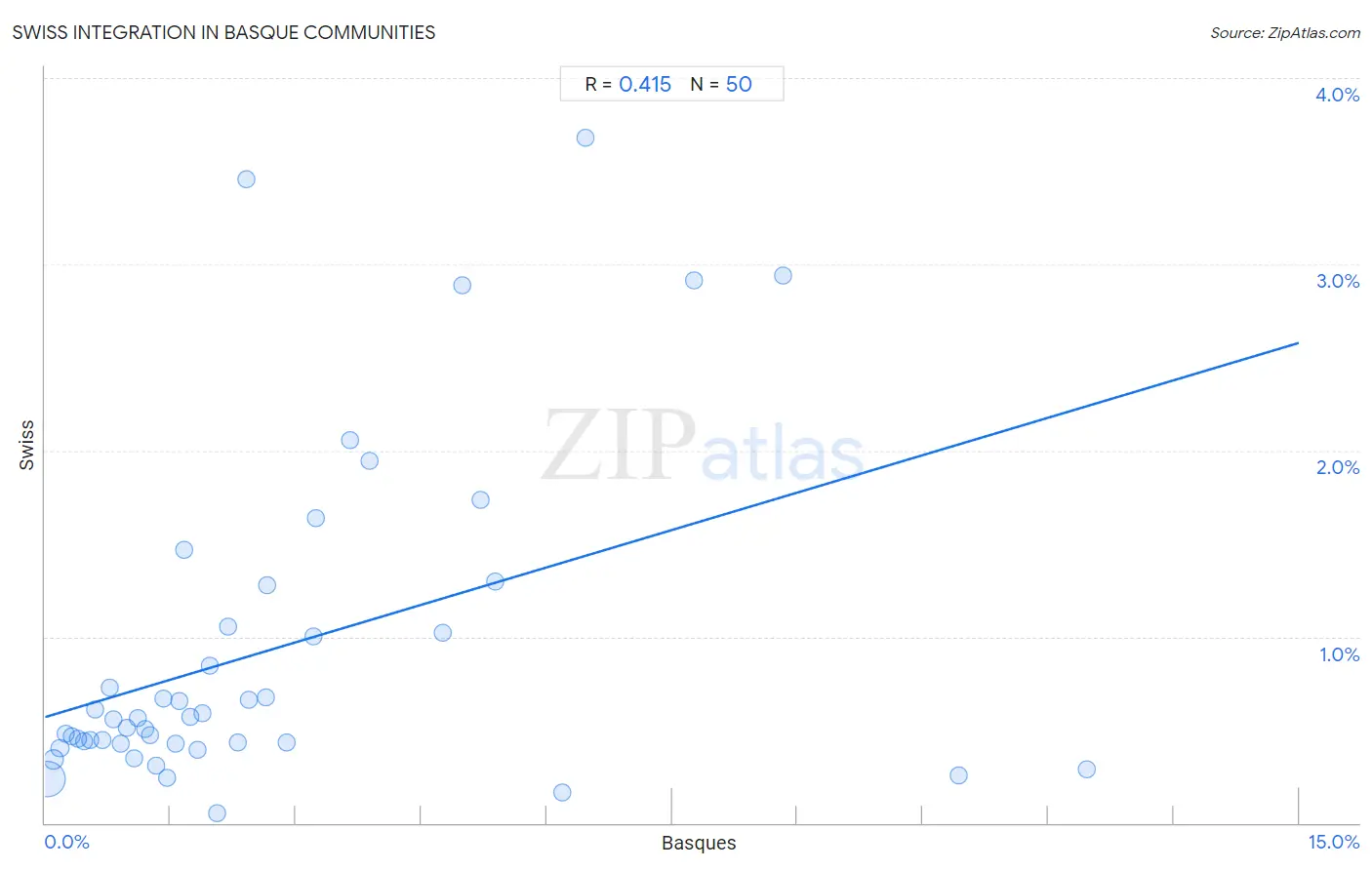
Basque vs Swiss Income
When considering income, the most significant differences between Basque and Swiss communities in the United States are seen in wage/income gap (28.8% compared to 30.0%, a difference of 4.1%), per capita income ($45,086 compared to $44,076, a difference of 2.3%), and householder income over 65 years ($62,653 compared to $61,621, a difference of 1.7%). Conversely, both communities are more comparable in terms of median earnings ($46,399 compared to $46,315, a difference of 0.18%), householder income ages 45 - 64 years ($103,387 compared to $103,071, a difference of 0.31%), and median family income ($104,760 compared to $104,396, a difference of 0.35%).

| Income Metric | Basque | Swiss |
| Per Capita Income | Excellent $45,086 | Good $44,076 |
| Median Family Income | Good $104,760 | Good $104,396 |
| Median Household Income | Good $87,001 | Average $85,681 |
| Median Earnings | Average $46,399 | Average $46,315 |
| Median Male Earnings | Good $55,370 | Good $55,731 |
| Median Female Earnings | Tragic $38,352 | Tragic $37,904 |
| Householder Age | Under 25 years | Fair $51,818 | Poor $51,493 |
| Householder Age | 25 - 44 years | Good $96,709 | Good $95,511 |
| Householder Age | 45 - 64 years | Excellent $103,387 | Good $103,071 |
| Householder Age | Over 65 years | Excellent $62,653 | Good $61,621 |
| Wage/Income Gap | Tragic 28.8% | Tragic 30.0% |
Basque vs Swiss Poverty
When considering poverty, the most significant differences between Basque and Swiss communities in the United States are seen in single father poverty (15.5% compared to 17.3%, a difference of 11.0%), seniors poverty over the age of 65 (10.2% compared to 9.2%, a difference of 10.4%), and female poverty among 18-24 year olds (21.7% compared to 20.2%, a difference of 7.5%). Conversely, both communities are more comparable in terms of female poverty among 25-34 year olds (13.4% compared to 13.4%, a difference of 0.21%), single female poverty (21.3% compared to 21.4%, a difference of 0.31%), and child poverty under the age of 5 (16.0% compared to 16.1%, a difference of 0.61%).
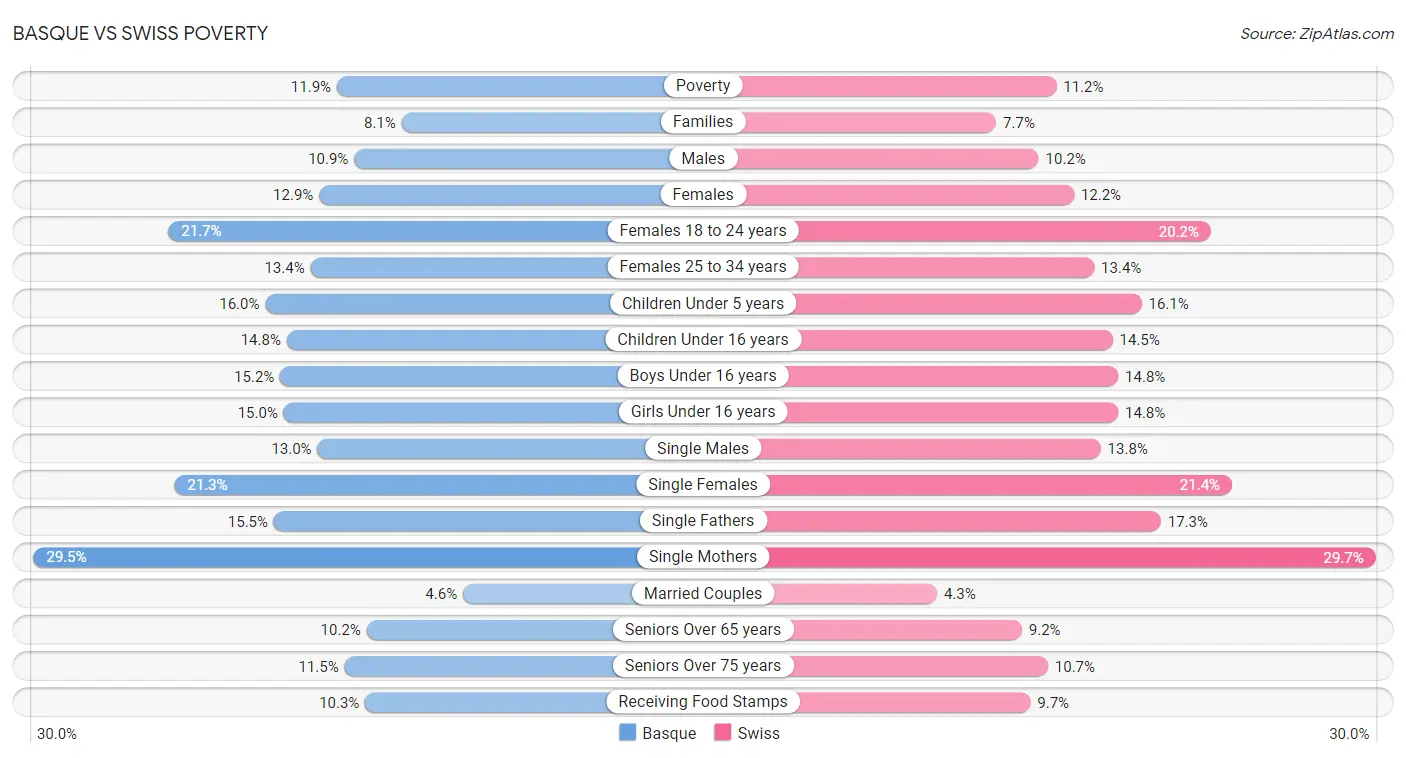
| Poverty Metric | Basque | Swiss |
| Poverty | Excellent 11.9% | Exceptional 11.2% |
| Families | Exceptional 8.1% | Exceptional 7.7% |
| Males | Good 10.9% | Exceptional 10.2% |
| Females | Excellent 12.9% | Exceptional 12.2% |
| Females 18 to 24 years | Tragic 21.7% | Average 20.2% |
| Females 25 to 34 years | Average 13.4% | Good 13.4% |
| Children Under 5 years | Exceptional 16.0% | Exceptional 16.1% |
| Children Under 16 years | Exceptional 14.8% | Exceptional 14.5% |
| Boys Under 16 years | Exceptional 15.2% | Exceptional 14.8% |
| Girls Under 16 years | Exceptional 15.0% | Exceptional 14.8% |
| Single Males | Fair 13.0% | Tragic 13.8% |
| Single Females | Fair 21.3% | Fair 21.4% |
| Single Fathers | Exceptional 15.5% | Tragic 17.3% |
| Single Mothers | Fair 29.5% | Poor 29.7% |
| Married Couples | Exceptional 4.6% | Exceptional 4.3% |
| Seniors Over 65 years | Exceptional 10.2% | Exceptional 9.2% |
| Seniors Over 75 years | Exceptional 11.5% | Exceptional 10.7% |
| Receiving Food Stamps | Exceptional 10.3% | Exceptional 9.7% |
Basque vs Swiss Unemployment
When considering unemployment, the most significant differences between Basque and Swiss communities in the United States are seen in unemployment among seniors over 75 years (8.1% compared to 9.5%, a difference of 17.4%), female unemployment (5.1% compared to 4.6%, a difference of 12.1%), and unemployment among women with children ages 6 to 17 years (8.2% compared to 9.0%, a difference of 10.4%). Conversely, both communities are more comparable in terms of unemployment among women with children under 6 years (7.8% compared to 7.9%, a difference of 1.4%), unemployment among ages 30 to 34 years (5.4% compared to 5.3%, a difference of 2.7%), and unemployment among ages 60 to 64 years (4.8% compared to 4.6%, a difference of 4.0%).
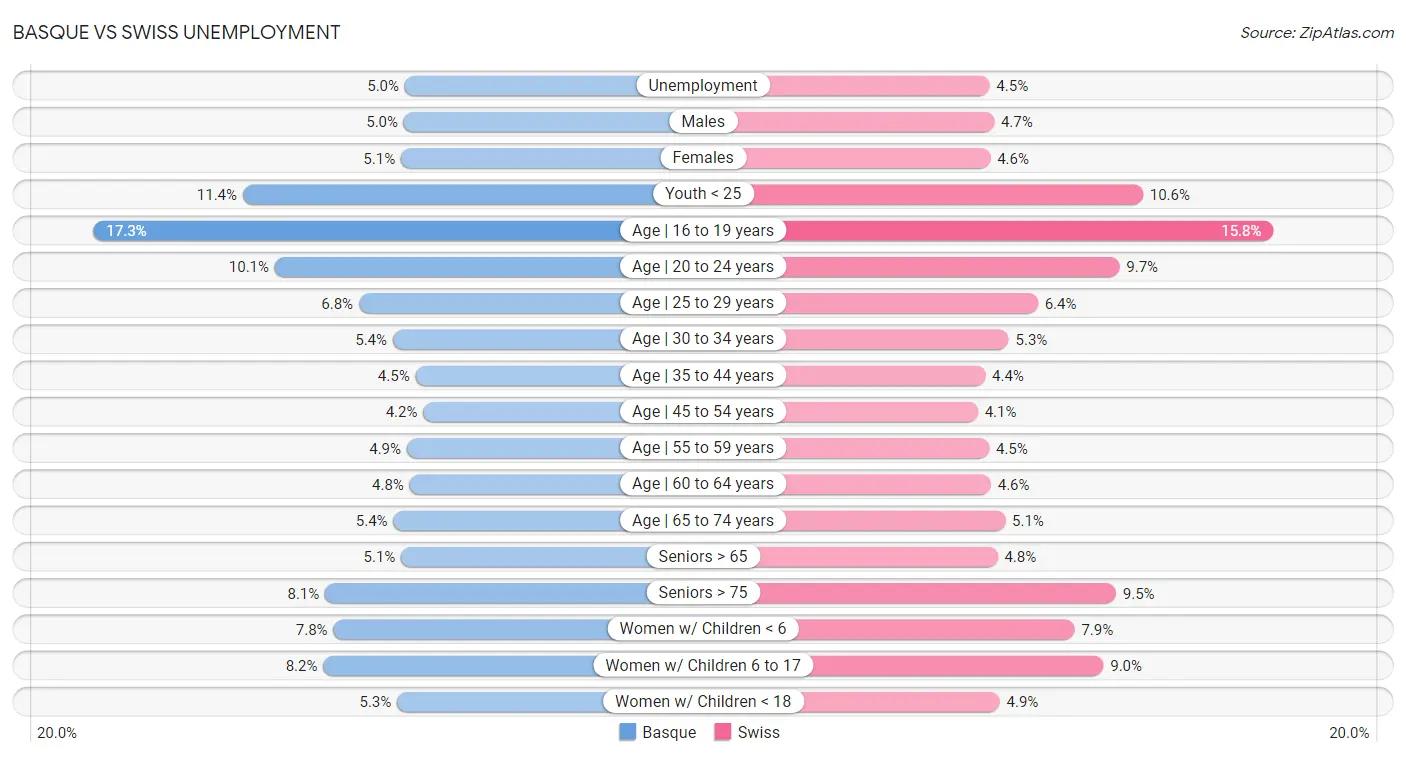
| Unemployment Metric | Basque | Swiss |
| Unemployment | Exceptional 5.0% | Exceptional 4.5% |
| Males | Exceptional 5.0% | Exceptional 4.7% |
| Females | Excellent 5.1% | Exceptional 4.6% |
| Youth < 25 | Excellent 11.4% | Exceptional 10.6% |
| Age | 16 to 19 years | Excellent 17.3% | Exceptional 15.8% |
| Age | 20 to 24 years | Excellent 10.1% | Exceptional 9.7% |
| Age | 25 to 29 years | Fair 6.8% | Excellent 6.4% |
| Age | 30 to 34 years | Average 5.4% | Excellent 5.3% |
| Age | 35 to 44 years | Excellent 4.5% | Exceptional 4.4% |
| Age | 45 to 54 years | Exceptional 4.2% | Exceptional 4.1% |
| Age | 55 to 59 years | Fair 4.9% | Exceptional 4.5% |
| Age | 60 to 64 years | Excellent 4.8% | Exceptional 4.6% |
| Age | 65 to 74 years | Fair 5.4% | Exceptional 5.1% |
| Seniors > 65 | Good 5.1% | Exceptional 4.8% |
| Seniors > 75 | Exceptional 8.1% | Tragic 9.5% |
| Women w/ Children < 6 | Fair 7.8% | Poor 7.9% |
| Women w/ Children 6 to 17 | Exceptional 8.2% | Fair 9.0% |
| Women w/ Children < 18 | Excellent 5.3% | Exceptional 4.9% |
Basque vs Swiss Labor Participation
When considering labor participation, the most significant differences between Basque and Swiss communities in the United States are seen in in labor force | age 16-19 (39.3% compared to 43.3%, a difference of 10.2%), in labor force | age 25-29 (83.4% compared to 84.7%, a difference of 1.6%), and in labor force | age 20-24 (76.5% compared to 77.7%, a difference of 1.5%). Conversely, both communities are more comparable in terms of in labor force | age > 16 (64.2% compared to 64.4%, a difference of 0.32%), in labor force | age 30-34 (84.0% compared to 84.3%, a difference of 0.33%), and in labor force | age 35-44 (83.6% compared to 84.2%, a difference of 0.71%).

| Labor Participation Metric | Basque | Swiss |
| In Labor Force | Age > 16 | Tragic 64.2% | Tragic 64.4% |
| In Labor Force | Age 20-64 | Tragic 78.7% | Fair 79.4% |
| In Labor Force | Age 16-19 | Exceptional 39.3% | Exceptional 43.3% |
| In Labor Force | Age 20-24 | Exceptional 76.5% | Exceptional 77.7% |
| In Labor Force | Age 25-29 | Tragic 83.4% | Good 84.7% |
| In Labor Force | Age 30-34 | Tragic 84.0% | Tragic 84.3% |
| In Labor Force | Age 35-44 | Tragic 83.6% | Poor 84.2% |
| In Labor Force | Age 45-54 | Tragic 82.0% | Average 82.8% |
Basque vs Swiss Family Structure
When considering family structure, the most significant differences between Basque and Swiss communities in the United States are seen in single father households (2.5% compared to 2.3%, a difference of 8.7%), divorced or separated (12.6% compared to 12.0%, a difference of 5.1%), and currently married (48.1% compared to 49.7%, a difference of 3.3%). Conversely, both communities are more comparable in terms of family households with children (27.7% compared to 27.7%, a difference of 0.070%), family households (64.7% compared to 65.2%, a difference of 0.83%), and average family size (3.19 compared to 3.15, a difference of 1.1%).

| Family Structure Metric | Basque | Swiss |
| Family Households | Excellent 64.7% | Exceptional 65.2% |
| Family Households with Children | Good 27.7% | Excellent 27.7% |
| Married-couple Households | Exceptional 48.4% | Exceptional 49.9% |
| Average Family Size | Tragic 3.19 | Tragic 3.15 |
| Single Father Households | Tragic 2.5% | Good 2.3% |
| Single Mother Households | Exceptional 5.7% | Exceptional 5.6% |
| Currently Married | Exceptional 48.1% | Exceptional 49.7% |
| Divorced or Separated | Tragic 12.6% | Good 12.0% |
| Births to Unmarried Women | Exceptional 29.7% | Excellent 30.5% |
Basque vs Swiss Vehicle Availability
When considering vehicle availability, the most significant differences between Basque and Swiss communities in the United States are seen in 4 or more vehicles in household (8.4% compared to 7.8%, a difference of 8.7%), 3 or more vehicles in household (24.3% compared to 23.0%, a difference of 5.4%), and no vehicles in household (7.8% compared to 7.9%, a difference of 1.1%). Conversely, both communities are more comparable in terms of 1 or more vehicles in household (92.4% compared to 92.3%, a difference of 0.11%), 2 or more vehicles in household (61.4% compared to 61.0%, a difference of 0.65%), and no vehicles in household (7.8% compared to 7.9%, a difference of 1.1%).

| Vehicle Availability Metric | Basque | Swiss |
| No Vehicles Available | Exceptional 7.8% | Exceptional 7.9% |
| 1+ Vehicles Available | Exceptional 92.4% | Exceptional 92.3% |
| 2+ Vehicles Available | Exceptional 61.4% | Exceptional 61.0% |
| 3+ Vehicles Available | Exceptional 24.3% | Exceptional 23.0% |
| 4+ Vehicles Available | Exceptional 8.4% | Exceptional 7.8% |
Basque vs Swiss Education Level
When considering education level, the most significant differences between Basque and Swiss communities in the United States are seen in no schooling completed (1.8% compared to 1.5%, a difference of 19.3%), professional degree (4.6% compared to 4.5%, a difference of 3.8%), and college, under 1 year (67.6% compared to 65.5%, a difference of 3.1%). Conversely, both communities are more comparable in terms of nursery school (98.2% compared to 98.6%, a difference of 0.32%), kindergarten (98.2% compared to 98.5%, a difference of 0.32%), and 1st grade (98.2% compared to 98.5%, a difference of 0.32%).
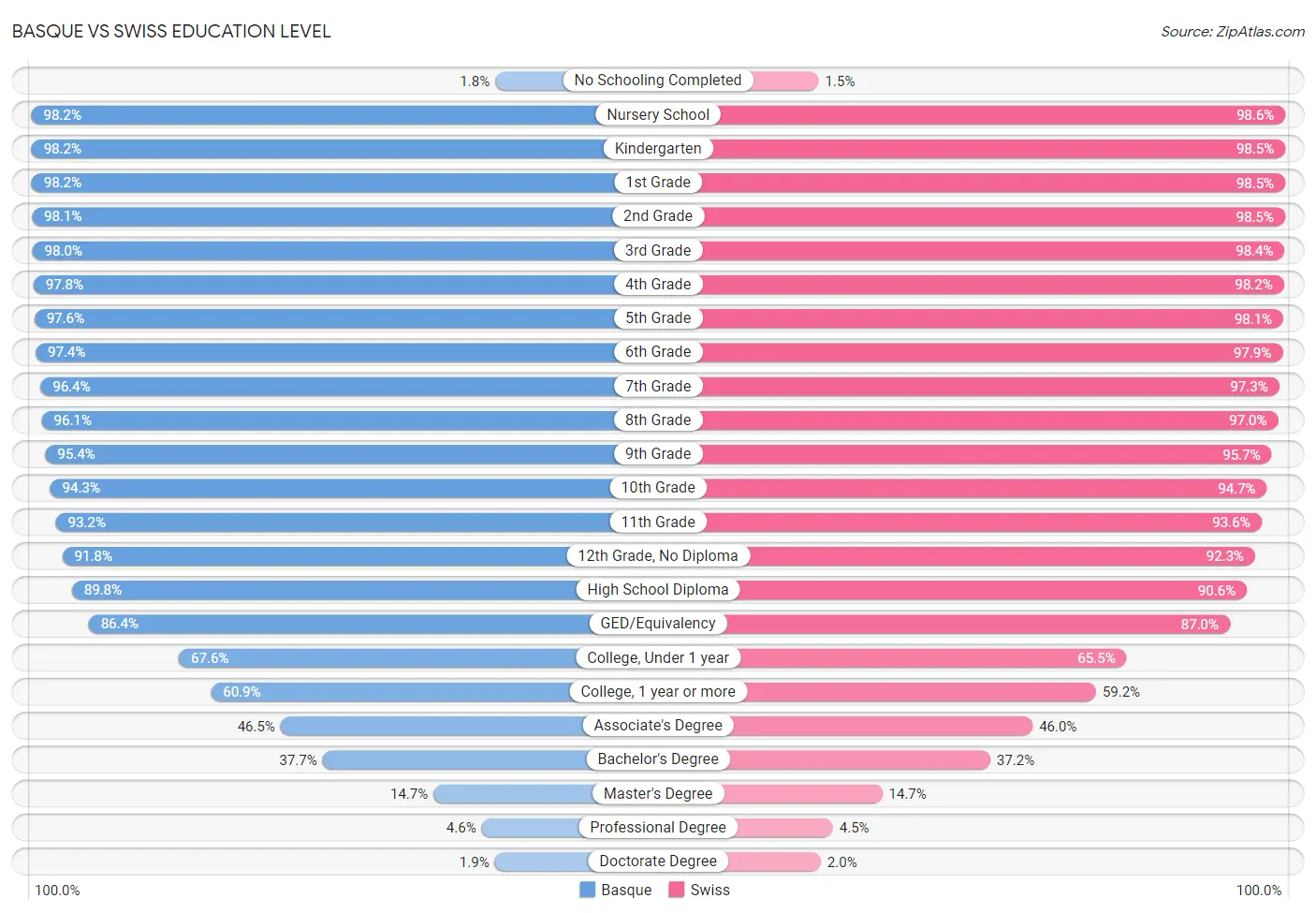
| Education Level Metric | Basque | Swiss |
| No Schooling Completed | Exceptional 1.8% | Exceptional 1.5% |
| Nursery School | Exceptional 98.2% | Exceptional 98.6% |
| Kindergarten | Exceptional 98.2% | Exceptional 98.5% |
| 1st Grade | Exceptional 98.2% | Exceptional 98.5% |
| 2nd Grade | Exceptional 98.1% | Exceptional 98.5% |
| 3rd Grade | Exceptional 98.0% | Exceptional 98.4% |
| 4th Grade | Exceptional 97.8% | Exceptional 98.2% |
| 5th Grade | Exceptional 97.6% | Exceptional 98.1% |
| 6th Grade | Exceptional 97.4% | Exceptional 97.9% |
| 7th Grade | Excellent 96.4% | Exceptional 97.3% |
| 8th Grade | Exceptional 96.1% | Exceptional 97.0% |
| 9th Grade | Exceptional 95.4% | Exceptional 95.7% |
| 10th Grade | Exceptional 94.3% | Exceptional 94.7% |
| 11th Grade | Exceptional 93.2% | Exceptional 93.6% |
| 12th Grade, No Diploma | Exceptional 91.8% | Exceptional 92.3% |
| High School Diploma | Excellent 89.8% | Exceptional 90.6% |
| GED/Equivalency | Good 86.4% | Exceptional 87.0% |
| College, Under 1 year | Exceptional 67.6% | Average 65.5% |
| College, 1 year or more | Excellent 60.9% | Average 59.2% |
| Associate's Degree | Average 46.5% | Average 46.0% |
| Bachelor's Degree | Average 37.7% | Fair 37.2% |
| Master's Degree | Fair 14.7% | Average 14.7% |
| Professional Degree | Excellent 4.6% | Good 4.5% |
| Doctorate Degree | Good 1.9% | Excellent 2.0% |
Basque vs Swiss Disability
When considering disability, the most significant differences between Basque and Swiss communities in the United States are seen in disability age under 5 (1.3% compared to 1.6%, a difference of 22.0%), vision disability (2.3% compared to 2.2%, a difference of 5.6%), and disability age over 75 (47.6% compared to 46.2%, a difference of 3.0%). Conversely, both communities are more comparable in terms of disability (12.2% compared to 12.2%, a difference of 0.040%), disability age 35 to 64 (11.6% compared to 11.6%, a difference of 0.10%), and disability age 18 to 34 (7.4% compared to 7.4%, a difference of 0.14%).
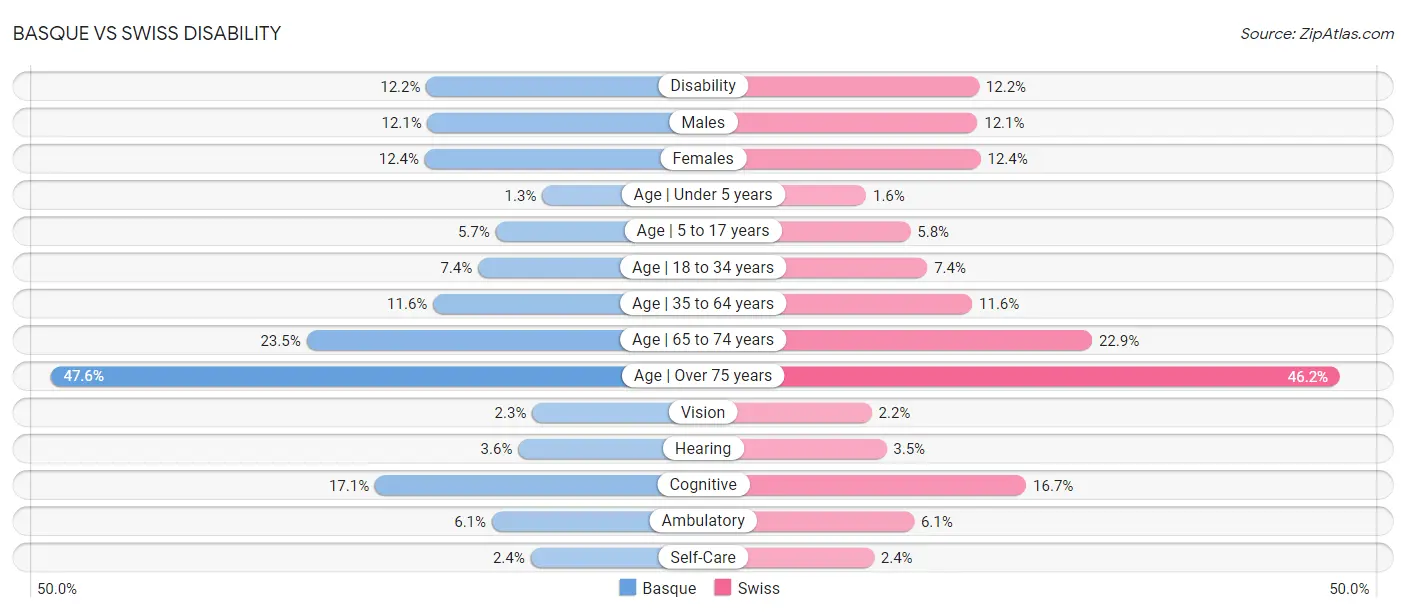
| Disability Metric | Basque | Swiss |
| Disability | Tragic 12.2% | Tragic 12.2% |
| Males | Tragic 12.1% | Tragic 12.1% |
| Females | Poor 12.4% | Poor 12.4% |
| Age | Under 5 years | Tragic 1.3% | Tragic 1.6% |
| Age | 5 to 17 years | Poor 5.7% | Tragic 5.8% |
| Age | 18 to 34 years | Tragic 7.4% | Tragic 7.4% |
| Age | 35 to 64 years | Poor 11.6% | Poor 11.6% |
| Age | 65 to 74 years | Fair 23.5% | Good 22.9% |
| Age | Over 75 years | Fair 47.6% | Exceptional 46.2% |
| Vision | Tragic 2.3% | Average 2.2% |
| Hearing | Tragic 3.6% | Tragic 3.5% |
| Cognitive | Excellent 17.1% | Exceptional 16.7% |
| Ambulatory | Good 6.1% | Average 6.1% |
| Self-Care | Good 2.4% | Exceptional 2.4% |